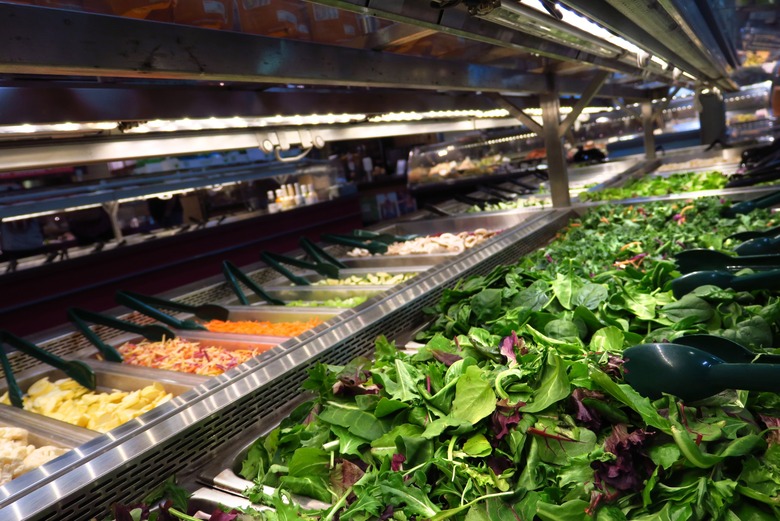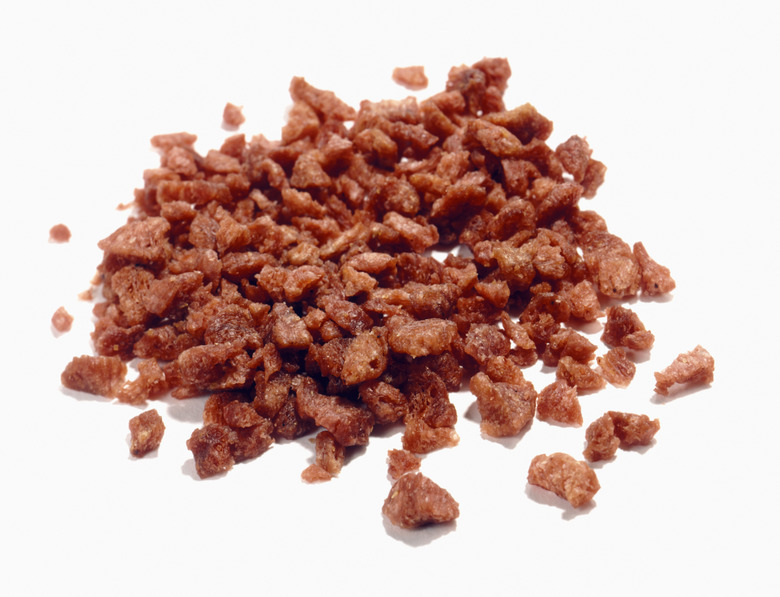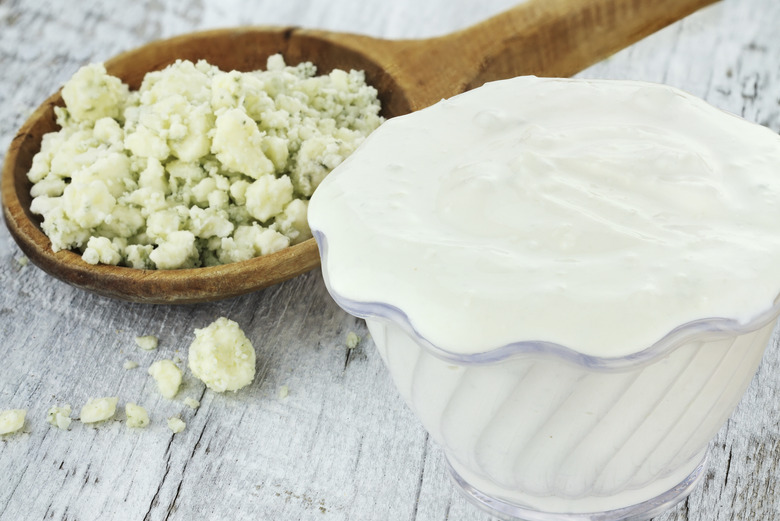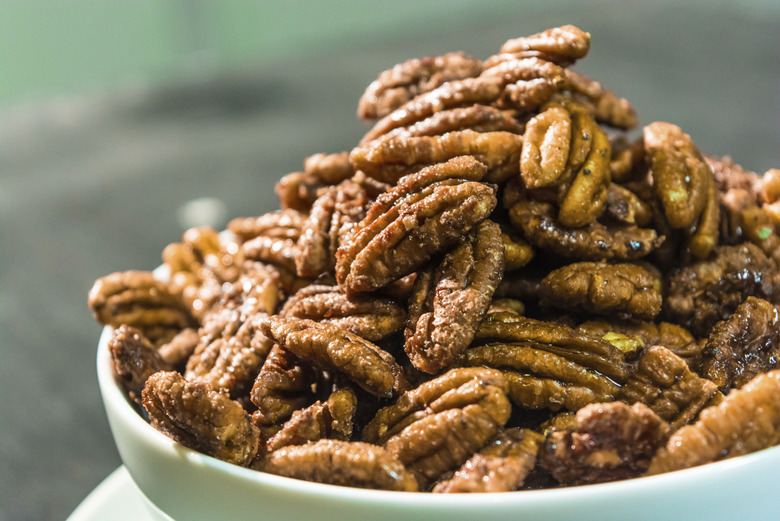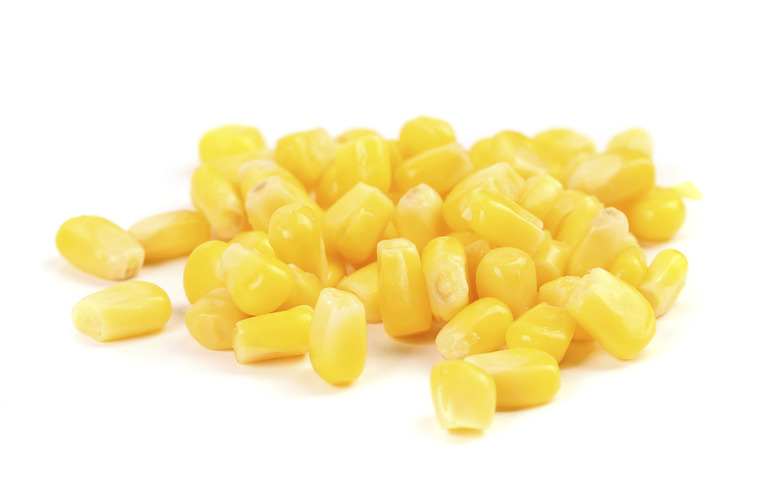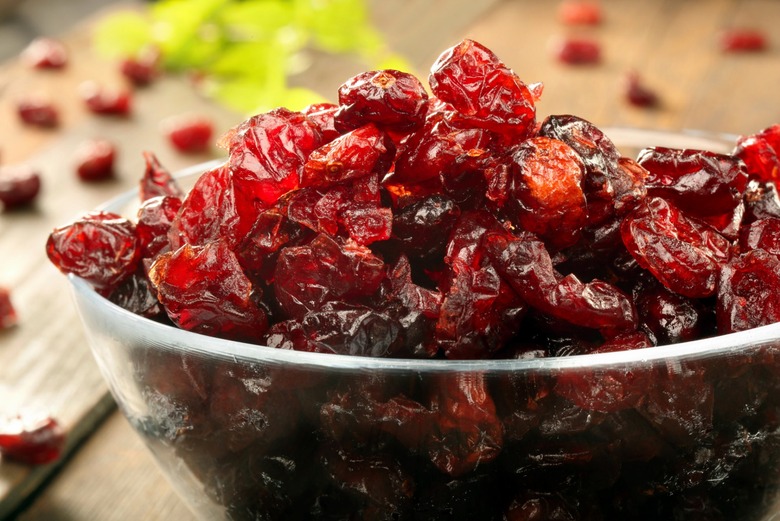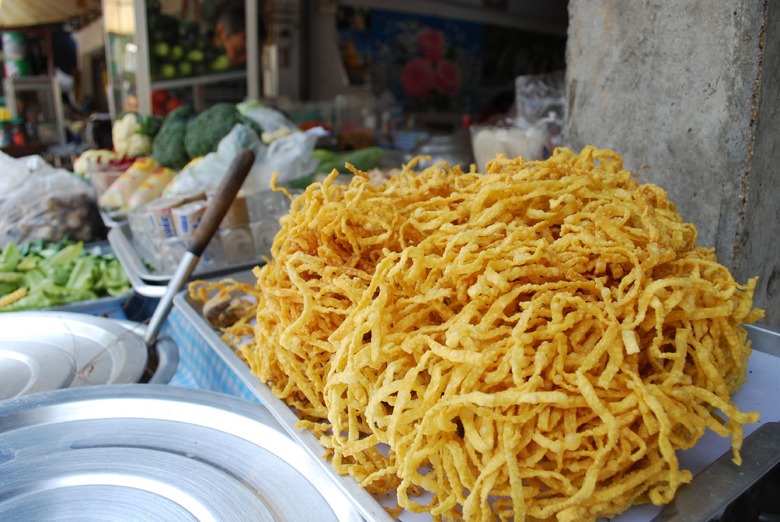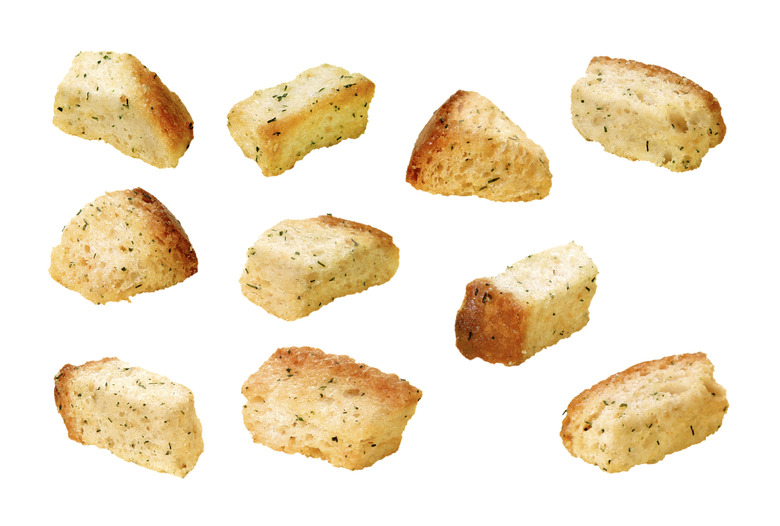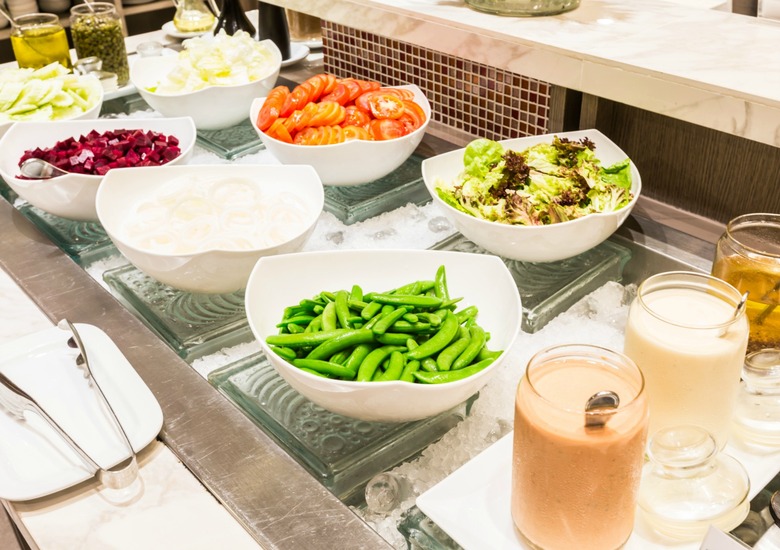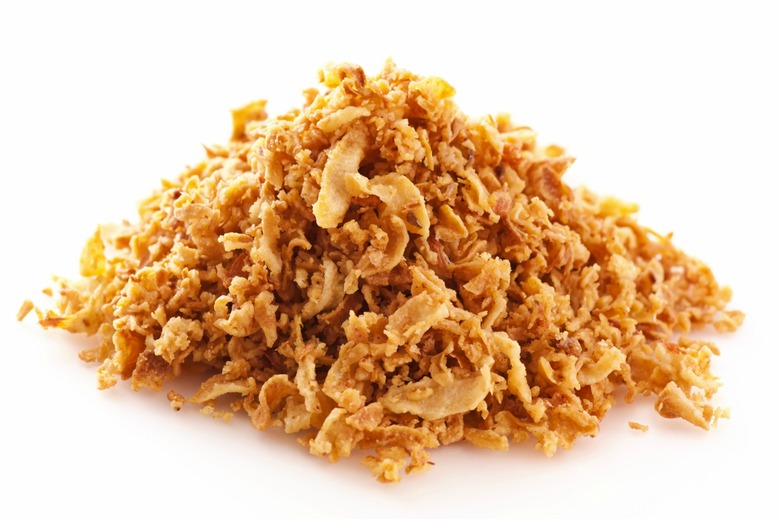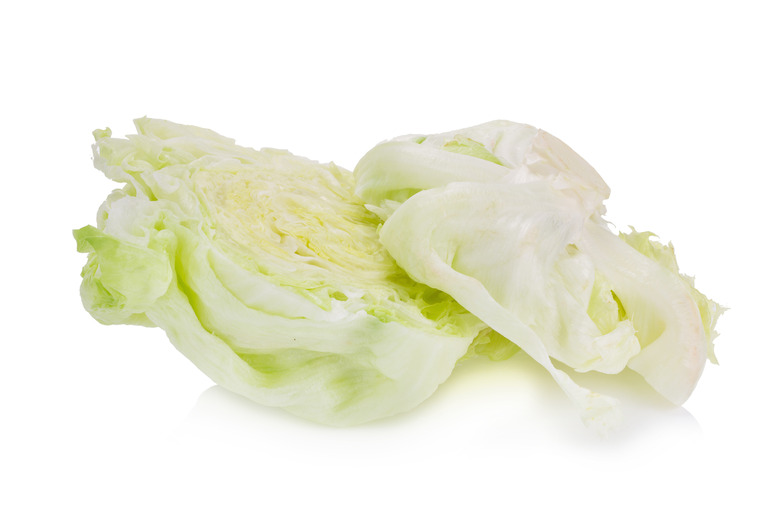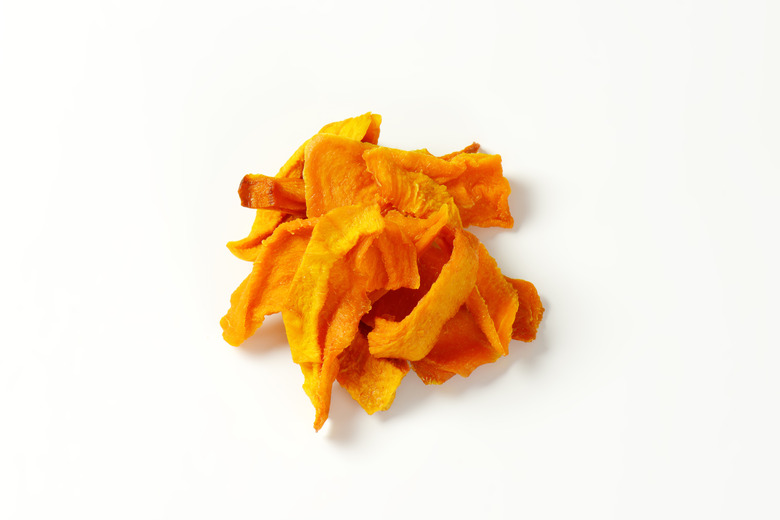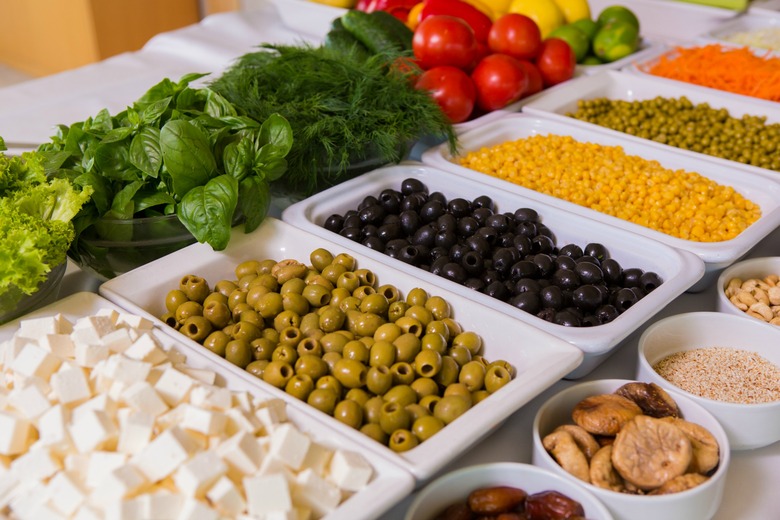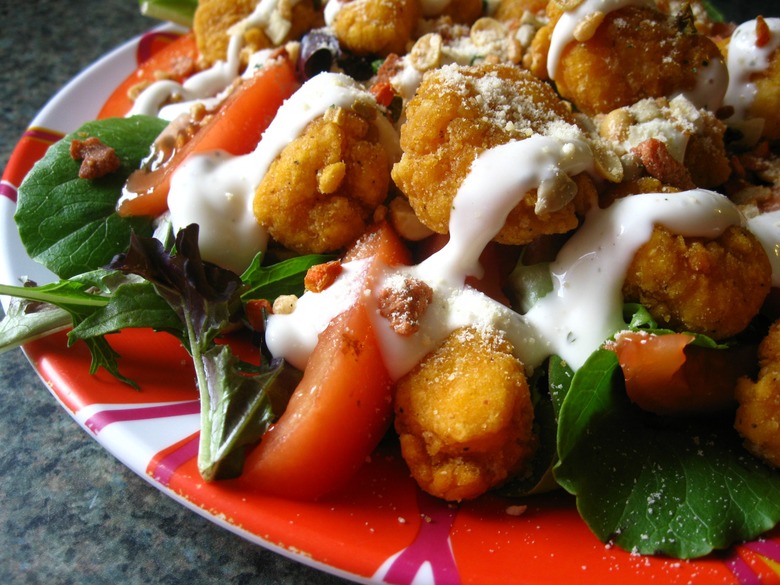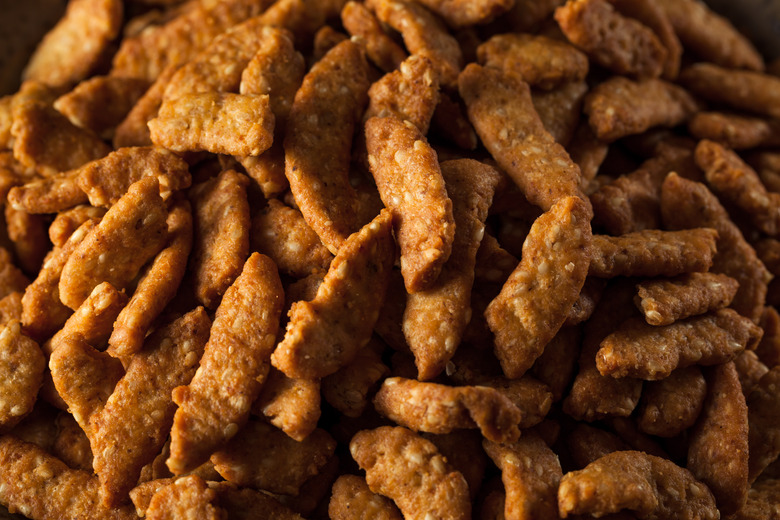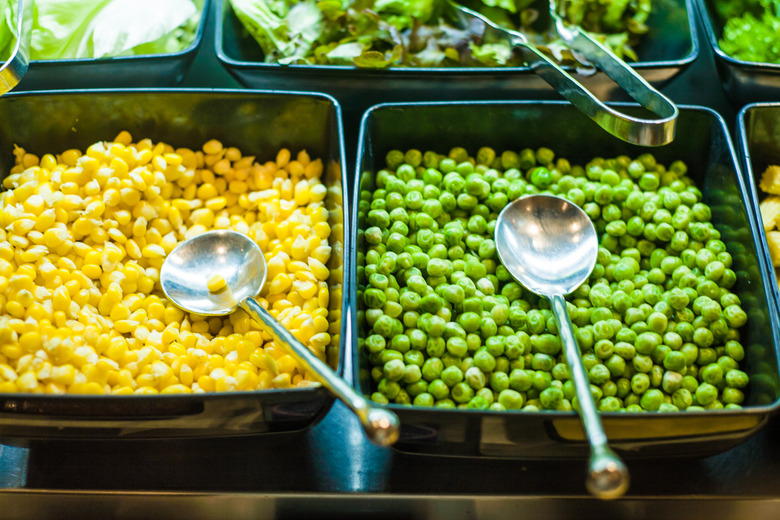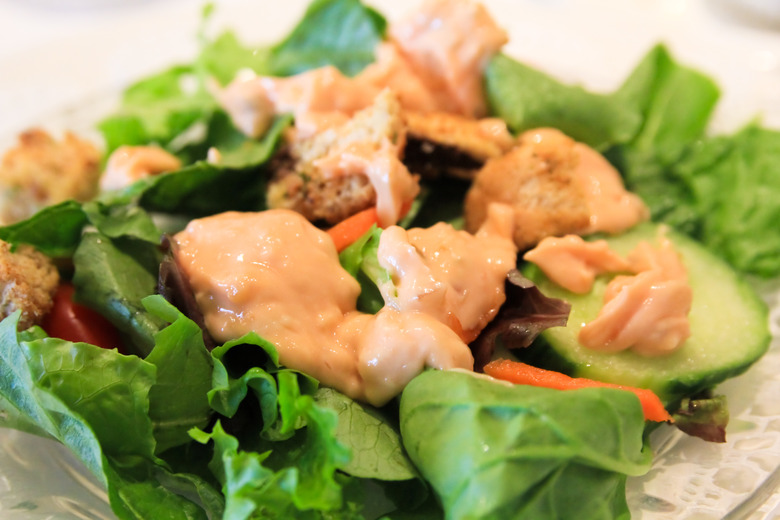Don't Let These Salad Bar Ingredients Fool You: They're Just Not Healthy
While some people pass on salad when they go out to dinner, disdaining it as "rabbit food," others are adamant proponents of what salad has to offer. Salads can be enjoyed year round — in fact, we have a great list of 50 Salad Recipes for All Seasons. They're generally considered a healthy option, and when you're making your own you can make them incredibly nutritious. When you're dining out, though, you usually don't have too much control over what goes into your salad. The one exception comes in the form of the nearly mythically praised salad bar.
For those who don't consider salad fodder for rabbits, salad bars are a great way to control what goes into your appetizer course. You can do your best to make the ultimate Cobb salad, or you can just get an entire plate of sliced cucumbers and go to town on them. If you're particularly crafty, you can manage to create something close to a salad from our list of 50 sensational salad recipes. The possibilities aren't endless, but they're vast, and they can quickly become vastly unhealthy.
From pointless salad ingredients that render a healthy dish unnecessarily fatty or sugary to salad dressings that are so far from healthy that it's almost laughable, every dip of the tong or ladle into a salad bar tray is potentially dangerous. Don't step on a dietary land mine when you're enjoying the salad bar with family or friends. Let us tell you which diet-ruining foods to avoid the next time you're standing above the sneeze guard, cold plate in one hand and shining tongs in the other.
Bacon Bits
There's a reason that bacon made our list of 27 Foods Doctors Won't Eat and Why: Bacon is basically all cholesterol and fat. The good thing about bacon, though, is that it is real meat. Many bacon bits are actually imitation bacon that's made from ingredients like textured soy flour, caramel color, canola oil, and maltodextrin.
Blue Cheese Dressing
Blue cheese itself is just protein and fat, and many people can find a way to work it into a healthy diet. Salads that come with blue cheese dressing and those wedge salads that come with heaping piles of blue cheese boulders, though, are incredibly fatty and calorie-dense. Many bottled versions contain upwards of 16 grams of fat and 160 milligrams of sodium.
Candied Nuts
Walnuts are one of the healthiest nuts out there, and pecans aren't half bad either. When you coat them in sticky, sugary coatings, however, their nutrition truly goes down the drain, or it shoots up the chocolate tube, if a Willy Wonka reference works better for you — "Take Mrs. Gloop to the Fudge Room, but look sharp or her boy will go in the boiler." One 28 gram serving of candied pecans has four grams of sugar whereas raw pecans have one gram of sugar, and 28 grams of candied walnuts have eight grams of sugar versus virtually zero grams in raw walnuts.
Corn
Starchy vegetables like corn really shouldn't be deemed unhealthy, but they should be consumed with caution and should play little to no role in a true healthy eater's diet. Corn, one of the most genetically modified foodstuffs, contains 124 calories and 30 grams of carbohydrates per cup (about five of which come from sugar). It doesn't hold a candle to truly healthy vegetables like spinach (seven or so calories per cup, one gram of carbs, and essentially no sugar), and it's no wonder that countries like Russia and France are beginning to ban GMO corn. The safety of modified corn has been called to question incessantly over the past decade.
Craisins
Dried fruits made our list of 27 "Health Foods" That Aren't That Healthy because most of them aren't just dried fruit. Craisins, dried cranberries, contain a whopping 20 grams of sugar per 28-gram serving. That's 80 out of a serving's 100 calories purely from sugar. Since most salad bars don't contain any of the most nutritious fruits you can eat, we suggest holding off on the need to get your fruit fix until you find some options that don't contain tons of added sugar.
Crispy Noodles
Crispy is essentially synonymous with "this food was fried in low-quality oil" and/or "dangerously unhealthy." The next time you see "dangerously unhealthy" noodles at the salad bar, know that a half cup contains 150 calories, seven grams of fat (three of which are saturated), and 310 milligrams of sodium. Noodles are a source of carbohydrates, and healthy, whole-grain pasta made our list of 14 Complex Carbs to Help Shape Your Best Summer Body Yet, so it's odd to us that a serving of crispy noodles only has five grams of carbohydrates. Seek your salad bar crunch from heart-healthy sunflower seeds or unadulterated carrots.
Croutons
Like "dangerously unhealthy" noodles, croutons are one of the many unhealthy crunch options at salad bars. Just one-half of a cup of croutons can easily add 100 calories to your salad, and most croutons aren't made from healthy, sprouted grain breads. The croutons you'll find at a salad bar are made from regular old white bread, a food that has been proven unhealthy more times than we can count.
Fat-Free Dressing
Fat-free nearly always means "more sugar-laden," and this is a truth that is carried across the culinary board. Whether it's non-fat Greek yogurt or a fat-free salad dressing, a lack of fat is made possible through the addition of more sugar. Thus, choosing a fat-free or low-fat dressing may not always be a healthier option, depending on your own healthy eating parameters. While we're discussing fat and dressing, we'd be remiss not to note that extra virgin olive oil is one of the healthiest sources of dietary fat and also makes a great dressing. Don't fear the (healthy) fats.
Fried Onions
Fried onions are another food that no one can realistically say they thought was healthy. Like crispy noodles, fried onions have a cautionary word directly in their name. A blooming onion is a large-sized fried onion, a cousin of the shaved fried onions you can find at salad bars. Would you ever consider a blooming onion healthy?
Iceberg Lettuce
If you thought that choosing iceberg lettuce at the salad bar was a nutritious option because it's, well, lettuce, think again. Iceberg lettuce is basically just solidified water, and it often appears slightly frozen at lower quality salad bars. While even the highest quality salad bars probably don't provide kale as a greens option, they'll should provide spinach or a mesclun mix that includes spinach. We've said it before and we'll say it again: Spinach is one of the healthiest greens out there, and anyone can benefit from the guilt-free protein and iron that it provides.
Mango Strips
Like craisins and candied nuts, dried mango takes what was once a healthy ingredient and turns it into a chocolate-factory-style sweet. A 20-gram serving of dried mango strips has about 63 calories, 16 grams of carbs, and 15 grams of sugar. You're better off dipping your salad bar tongs into the mandarin orange tray (as long as they're not floating in syrup).
Olives
Olive oil is healthy (especially for your heart), and it's made from olives. Thus, why are olives unhealthy? This salad bar staple is deemed unhealthy because of sodium content. Just one small green olive can contain 25 milligrams of sodium on its own, and we guarantee you're not limiting your salads to one olive (your dirty martinis may be another story).
Ranch Dressing
Ranch dressing is a condiment made from a combination of buttermilk, sour cream, salt, garlic, and herbs, and, other than being featured in many salad bars, it's popularly used as a dip for cut vegetables or hot wings. One popular variety contains 310 milligrams of sodium and 16 grams of fat, rendering the holistic, healthy scene inspired by the word "ranch" a complete farce.
Sesame Sticks
We could just say "see entry for crispy noodles and croutons," but where would the fun be in that? Sesame sticks come in a variety of flavors, including honey-roasted, garlic, and Cajun, and you better believe that those flavors don't come without a bit of sodium and sugar. Even regular sesame sticks, a virtually sugar-free salad bar ingredient, aren't safe: They contain a whopping 400 milligrams of sodium per one-third of a cup. If you're going to a salad bar in New York City, sesame sticks would probably come flagged with a high-sodium warning.
Sweet Peas
Peas are green, but unlike nutritious dark leafy greens they're starchy and altogether not super healthy. Nearly half of the carbohydrates in a serving of sweet peas come from sugar. For example, a one-half cup serving has 10 grams of carbs and four grams of sugar. While we don't consider them an incredibly healthy salad bar option (we'd go as far as saying they're deceptively unhealthy), one resourceful person has figured out how to make peas into dairy-free milk.
Thousand Island Dressing
You didn't really think this stuff was healthy, did you? Thousand island dressing tastes far too good to truly be healthy, and its nutrition facts back that claim up. Popular brands contain about 12 or 13 grams of fat and upwards of 300 milligrams of sodium. Stick to heart-healthy extra virgin olive oil if you really can't tolerate a salad dry, and consider trying out a generations-old practice of squeezing lemon over your salad instead of using any of the aforementioned creamy, unhealthy dressings.
